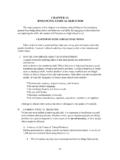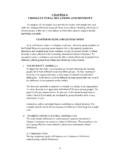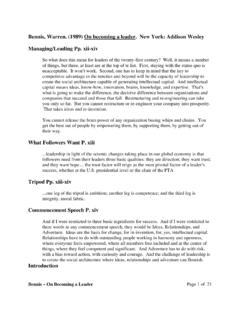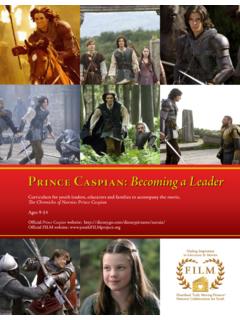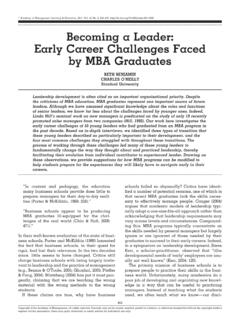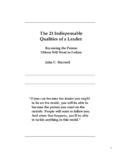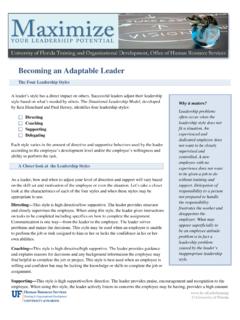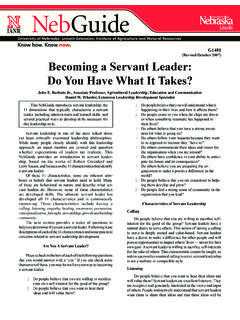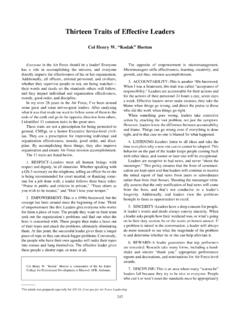Transcription of CHAPTER 8: BECOMING AN EFFECTIVE LEADER
1 98 CHAPTER 8: BECOMING AN EFFECTIVE LEADERThe purpose of this CHAPTER is to present information about leadership that studentscan apply to developing their leadership skills. As a consequence, we omit fromconsideration here the underlying leadership research and theory. Advanced students maywant to read the underlying knowledge base on their OUTLINE AND LECTURE NOTESTo develop leadership capability a person needs the right personal characteristics,and must carry out the right actions. Leadership is the ability to inspire support andconfidence among the people who are needed to achieve company goals. leaders make adifference. Leadership status can be derived from being appointed to a formal position orinspiring others through personal characteristics and KEY LEADERSHIP TRAITS TO DEVELOPAn important part of being an EFFECTIVE LEADER is to have the right stuff. Yet differentsituations may require a different set of personal characteristics for leadershipeffectiveness.
2 Each of the eight leadership traits described next can be Self-confidenceRealistic self-confidence is required in virtually every leadership situation. Theleader must also project self-confidence to the group. Self-confidence is also abehavior, such as being cool under pressure. Developing self-confidence is a life-longprocess of performing well in a variety of TrustworthinessGroup members consistently believe that leaders must display honesty, integrity,and credibility and therefore be trustworthy. Being honest with team membershelps to build trust, which in turn leads to good cooperation and team spirit. DaleZand says that trust, along with knowledge and power, are the three foundations widely-recognized leadership trait is assertiveness, being forthright in expressingdemands, opinions, feelings, and attitudes. Assertiveness helps leaders performtasks and achieve goals such as confronting people about their mistakes, and settinghigh expectations.
3 Assertiveness stands in contrast to aggressiveness and assertiveness is much like attempting to become less shy. People must99force themselves to take the opportunity to express their feelings and demands is easier for most people than expressing Emotional stability is important for a LEADER because group members expect andneed consistency in the way they are treated. Emotional stability is difficult todevelop, but people can learn to control many of their emotional Sense of a trait or a behavior, the EFFECTIVE use of humor is considered an importantpart of a LEADER s role. Self-effacing humor is the choice of comedians and organizational leaders alike. Humor requires Self-awareness and leaders are aware of their strengths and limitations, enabling them tocapitalize upon their strengths and develop their weaknesses. Self-awareness andself-objectivity can be developed by asking for feedback from others self-examination exercises is also Cognitive ability as well as personality is important for leadership and intellectual skills are referred to collectively as cognitivefactors.
4 Knowledge of the business, or technical skill, is another cognitive skill ofmajor Emotional IntelligenceEmotional intelligence also refers to being able to work effectively with theemotions of others and to resolve problems, including listening and research by Daniel Goleman suggests that superb leaders all have superbemotional intelligence. To develop emotional intelligence, look to understand thefeelings and emotions of people around Passion and EnthusiasmA prominent characteristic of EFFECTIVE leaders is the passion and enthusiasm theyhave for their work, much like the same quality in creative people. The passion isdirected toward the business, customers, and employees. To display passion andenthusiasm for your work, you must first find work that creates an inner FOR DEVELOPING CHARISMAMuch attention is being paid to the importance of inspirational leaders who guideothers toward great heights of achievement. Charisma is a special quality of leaderswhose purposes, powers, and extraordinary determination differentiate them fromothers.
5 Charisma reflects a subjective perception on the part of the person being100influenced. leaders at all levels can project charisma. Following are suggestions forbehaving in a charismatic Communicate a vision. (A vision describes an ideal version of the future.)2. Make frequent use of metaphors and Inspire trust and Be highly energetic and goal Be emotionally expressive and Make ample use of true Smile frequently, even if you are not in a happy Be Make everybody feel that he or she is quite important. 10. Multiply the effectiveness of your handshake. 11. Stand up straight and also use other nonverbal signals of self-confidence. 12. Be willing to take personal risks. 13. Be self-promotional. (Charismatic leaders toot their own horns.)Caution: being excessively and flamboyantly charismatic can backfire becauseothers may perceive you as DEVELOPING TEAM LEADERSHIP SKILLSWith the use of teams being so widespread, team leadership opportunities haveincreased.
6 The team LEADER acts as a facilitator and coach who shares decisionmaking with team members. A team LEADER practices participative leadership, orsharing authority with the group. Suggestions for developing team leadership Build a Mission Statement. A mission should contain a specific goal,purpose, and be optimistic and uplifting. The LEADER can help develop themission when the team is first formed or at any other time. Developing amission for a long-standing team breathes new life into its Your Team Members that they Are Trusted. An EFFECTIVE leadertrusts team members, and recognizes and rewards ethical behaviorparticularly when there is a temptation to be Team Members to Recognize Each Other s of a high-spirited team look for ways to encourage and praise each other. Team spirit develops as members receive frequent positivefeedback from each Establish a Sense of Urgency and High Performance Standards. To build teamwork, members need to believe that the team has urgent, constructive101purposes.
7 A demanding performance challenge helps create and sustain Encourage Honest Criticism. Being a good team LEADER includes offeringhonest feedback on mistakes and flawed Use Team Symbols. Symbols can be an EFFECTIVE team builder in sports aswell as in Use Peer Evaluations. With peer evaluations systems the team memberscontribute to the evaluation by submitting evaluations of each other. Peerevaluations contribute to teamwork because team members realize thathelping each other becomes as important as helping the Team Members See the big Picture. The team is likely to worktogether more smoothly when members have a clear understanding of howtheir work contributes to the Minimize Formation of In-Groups and Out-Groups. According to theleader-exchange model, leaders establish unique working relationshipswith group members. Avoid allowing these relationships to develop intoin-groups and out-groups, thereby hurting morale for some.
8 IV. DEVELOPING YOUR LEADERSHIP POTENTIALHere we describe five strategies for developing your leadership potential in additionto studying and participating in formal Acquire broad experience. (Because leadership varies somewhat with thesituation, leadership effectiveness can be improved by gaining supervisoryexperience in different settings.)2. Model EFFECTIVE leaders . (Observe capable leaders in action and then modelsome of their approaches.)3. Self-develop leadership traits and behaviors. (Identify several traits andbehaviors that need development, and then work on them with acombination of determination and training. A formal method of obtainingfeedback about your leadership effectiveness is the 360-degree survey.)4. Become an integrated human being. (The model LEADER is first and foremosta fully functioning person. The process of BECOMING a LEADER is the processof BECOMING an integrated human being. Also, know thyself.)
9 1025. Practice a little leadership. (Look for opportunities to exert a small amountof helpful leadership in contrast to waiting for opportunities to accomplishextraordinary deeds.)6. Help your LEADER lead. When you help people above you avoid a mistake orcapitalize upon an opportunity, you help the entire company. At the sametime, you are developing your ability to take the initiative and TO DISCUSSION AND REVIEW QUESTIONS1. Informal observation suggests that people who were voted the most likely tosucceed in high school are frequently found in leadership positions later in explanation can you offer for these predictions about success so often beingtrue?One strong possibility is that a person s leadership traits have already started todevelop in high school, such as being self-confident and passionate. Another is thatbeing voted the most likely to succeed is a big self-confidence booster that helpspropel the person into leadership positions later on in How do you explain the fact that a person can be a LEADER , although lacking a jobthat includes responsibility for others?
10 A person can exhibit leadership outside of a formal position by influencing theopinions of others. Being looked up to for advice is another indicator of What does it mean to say that a person has the right stuff for being a LEADER ?Having the right stuff for being a LEADER refers to having the right personalcharacteristics and traits to become a LEADER . For example, without appropriateself-confidence, intelligence, and personal appeal, it would be difficult for a personto function effectively as a Assertiveness is said to be important for leadership effectiveness. Yet can you givean example of an EFFECTIVE LEADER who is downright aggressive and obnoxious? (Ifnecessary, give an example from sports leadership.)Some entrepreneurial leaders are downright aggressive and obnoxious partlybecause they are so pressed for time. Corporate leaders are more likely to beassertive and genteel. A few successful athletic coaches are aggressive andobnoxious.

